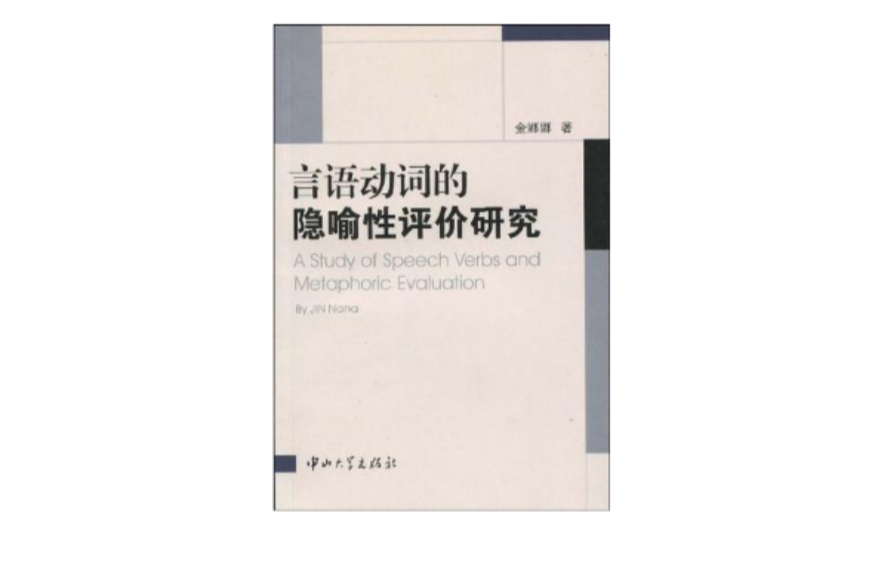基本介紹
- 書名:言語動詞的隱喻性評價研究
- 頁數: 270頁
- 出版社:中山大學出版社
- 開本: 32
內容簡介,圖書信息,作者簡介,目錄,
內容簡介
通過對言說經驗和系統功能語法中人際隱喻的認知分析,本文詳細說明了言語動詞如何隱喻性地表達評價意義。在分析言語動詞中,本文提出一種新的分類。言語動詞被劃分為以說話者、以受話者和以目標為主導的三類,每類動詞在表達意義時各有側重。本文從三個層面出發——小句層面下、小句層面中和小句層面上——探究了這些動詞表達評價意義的理據。所有這些分析都以英語本族人在文學著作、新聞報導、法庭和日常生活中的真實話語為語料。
首先,本文闡釋了前人對言語動詞和評價理論的研究,並介紹了四種研究言語動詞的主要途徑——傳統的途徑、言語行為理論、統計學途徑和系統功能語法理念。然而這些研究途徑都沒有重視言語動詞的人際意義。而就評價研究而言,雖然有哲學的和語言學的研究途徑,但是這些研究局限在形容詞上。因此,《言語動詞的隱喻性評價研究》擴展了評價的研究領域,並將言語動詞和評價分析聯繫起來。
其次,本文認為,言語動詞一旦出現,與之相關的是引述或轉述。當言說者/作者引述或轉述一個言語事件時,他對該事件的立場觀點通常由言語動詞顯性或隱性地體現出來。因而言語動詞被看做傳聞語的標記,且不能在法庭上作為證據。
實現評價的手段很多,例如表示態度的辭彙和情態隱喻。言語動詞具有隱喻性表達評價意義的潛勢,能夠將一個言語事件從圖形濃縮成成分。在小句層面以下,各種言語動詞間的關係例如蘊涵關係和方式關係,使隱喻性評價成為可能。
在小句中,言語動詞和心理描述動詞本質上能描述同一現象。言語動詞在本文中被認為是聲音化的思想並且能間接地表達言說者/作者的態度。這就是言語動詞的跨過程特徵。
最後,本文將隱喻性評價分析框架套用於分析新聞報導和法庭會話。分析結果表明,不同參與者在新聞報導中被賦予了不同的言語動詞。這就是說,言語動詞表明了記者對事件及其中人物的態度。對法庭語篇的分析表明了以說話者為中心的言語動詞比較客觀,並常用於開庭陳述中;然而以受話者和以目標為主導的言語動詞則比較主觀。
通過對言語動詞表達評價意義的研究,本文建立了一個新的評價子系統——隱喻性評價。基於對語料的分析,本文表明隱喻性評價方式在新聞報導和法庭語篇中表現非常突出。
圖書信息
ISBN: 9787306033437
條形碼: 9787306033437
尺寸: 20.8 x 14.2 x 1.6 cm
重量: 299 g
作者簡介
金娜娜(1977- ),貴州貴陽人。1999年畢業於貴州大學外語系,獲學士學位;2002年於江西師範大學外國語學院畢業,獲英語語言文學碩士學位:2005年從廈門大學英語語言文學專業畢業,獲博士學位。現為深圳大學外國語學院碩士生導師。研究方向為系統功能語言學、認知語言學和話語分析。曾先後在《外語教學與研究》、《外語教學》等國家級核心刊物上發表論文多篇,主編教材兩部,參與翻譯《麥克米倫高階英漢雙解詞典》,並多次參加國內外相關學術會議並宣讀論文,為中國功能語言學學會理事。已經主持完成深圳大學社科課題一項、教研課題一項,現主要負責深圳大學精品課程建設項目。
目錄
Acknowledgements
List of Figures and Tables
Introduction
1 The background of the research
2 The research purposes and significance
3 The research methodology and data collection
4 The organization of this book
Chapter 1 Previous Studies of Speech Verbs and Evaluation
1.1 Introduction
1.2 The definition of speech verbs
1.3 Four major approaches to speech verbs
1.3.1 The first major approach: the traditional approach
1.3.2 The second major approach: Speech Act Theory
1.3.3 The third major approach: statistics
1.3.4 The fourth major approach: Systemic Functional Grammar
1.4 Two major approaches to evaluation
1.4.1 The philosophical approach
1.4.2 The linguistic approach
1.4.3 Two major linguistic frameworks of evaluation
1.5 The shortcomings of previous studies
1.6 Summary
Chapter 2 Speech Verbs and the Reporting Nature
2.1 Introduction
2.2 A new classification of speech verbs
2.3 The syntactic properties of speech verbs
2.3.1 The addresser: Sayer
2.3.2 The addressee: Receiver
2.3.3 Sentence frames
2.3.4 "Wh-" words
2.4 The reporting nature of speech verbs
2.4.1 Speech verbs and reporting
2.4.2 Direct speech and indirect speech
2.4.3 The performative function of reporting.
2.5 The performances of speech verbs
2.5.1 Speech verbs and a speaker/writer's responsibility
2.5.2 Speech verbs as hearsay markers
2.6 Summary
Chapter 3 Metaphoric Evaluation
3.1 Introduction
3.2 Grammatical metaphor: the basis of metaphoric evaluation
3.2.1 Ideational metaphor
3.2.2 Interpersonal metaphor
3.3 Two motivations of metaphoric evaluation
3.3.1 Speech verbs' features of expressing evaluative meanings
3.3.2 Realizing interpersonal metaphor through speech verbs
3.4 The topological interpretation of interpersonal metaphor
3.5 Summary
Chapter 4 A Study of Speech Verbs Below the Clause
4.1 Introduction
4.2 Speech experience and speech verbs
4.2.1 From a sequence to a figure
4.2.2 From a figure/sequence to an element
4.2.3 From a figure to another kind of figure
4.3 Two relations of speech verbs' meanings and the software WordNet
4.3.1 Entailment
4.3.2 Troponymy
4.3.3 WordNet: setting up a topological structure of speech verbs
4.4 The method of identifying speech verbs' evaluative meanings
4.5 Summary
Chapter 5 A Study of Speech Verbs Above the Clause and Beyond the Clause
5.1 Introduction
5.2 Features of speech verbs cross-process and cross-function
5.2.1 Verbal and behavioral processes
5.2.2 Verbal and mental processes
5.2.3 Verbal and relational processes
5.3 The evaluative analysis of speech verbs in news reporting: above the clause
5.3.1 Words Location: a software designed for this research
5.3.2 The cognitive analysis of news reporting's foundation
5.3.3 The similarities of news reporting and conversation reporting
5.3.4 The analysis of speech verbs in news reporting: above the clause
5.4 The evaluative analysis of speech verbs in courtroom discourse: above the clause
5.4.1 The evaluative analysis of speech verbs in opening statements
5.4.2 The evaluative analysis of speech verbs in direct examinations
5. 5 The studies of speech verbs beyond the dause
5.5.1 The tense of speech verbs and evaluation
5.5.2 A case study of say beyond the clause
5. 6 Summary
Conclusion
Appendix 1 The Classification of 236 Speech Act Verbs by Wierzbicka
Appendix 2 The Senses of Apply Given by WordNet 2. 0
Appendix 3 The Application of Words Location
Appendix 4 Sample Concordance Lines for Say
Appendix 5 Data Samples
Bibliography

